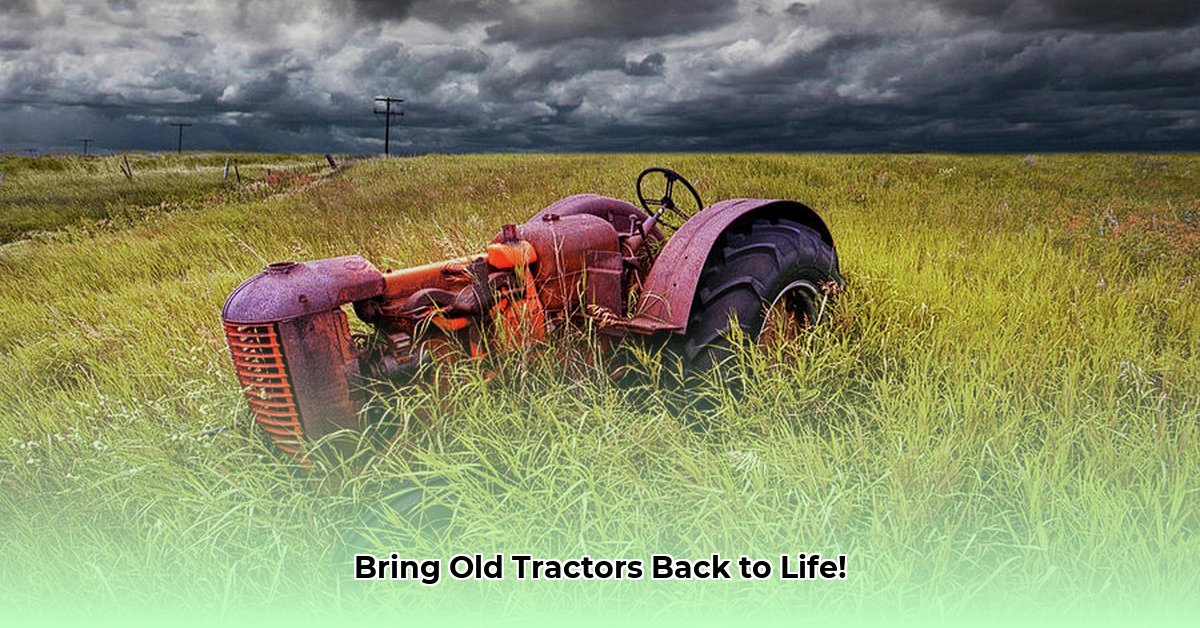
Imagine stumbling upon a forgotten giant in a field—a rusty old tractor, silently whispering tales of harvests past. These aren't just piles of metal; they're pieces of history, waiting for someone with the passion and know-how to bring them back to life. This guide provides a roadmap to restoring abandoned tractors, covering everything from feasibility assessments to sourcing parts and tackling those tricky repairs. Get ready to roll up your sleeves and discover the magic of revitalizing a vintage tractor.
Assessing Your Tractor Restoration Project: A Realistic Approach
Before you even think about touching a wrench, let's get real about restoring these rusty beauties. This isn't a weekend project; it's a commitment requiring careful planning and realistic expectations.
Feasibility: Is This Project Right for You?
Before you begin, honestly assess your capabilities and resources. Restoring a vintage tractor is a significant undertaking. Ask yourself:
Mechanical Aptitude: Do you possess basic mechanical skills or are you willing to learn? Some basic knowledge is essential, but extensive experience isn't required. Numerous online resources and communities can assist you.
Time Commitment: Restoration can take months, even years. Are you prepared to dedicate this substantial time investment? Be realistic about your schedule and available time.
Budget Constraints: Parts for vintage tractors can be expensive, and unforeseen issues will arise. Create a detailed budget that incorporates potential cost overruns. Having a contingency fund is highly recommended.
Legal Compliance: Clarify ownership and obtain any necessary permits before beginning the project. Consult legal professionals to mitigate potential legal complications. This step is critical to avoid future issues.
Your Step-by-Step Tractor Restoration Guide
This outline provides a general framework for restoring an abandoned tractor. Each tractor is unique, so adapt this guide to your project's specific needs.
Phase 1: Initial Assessment and Documentation
Thorough Inspection: Document the tractor's condition meticulously, taking many photos and videos. Note every detail, from rust spots to missing parts. This documentation forms the foundation of your restoration plan.
Parts Inventory: Compile a comprehensive list of required parts, researching availability and cost. Sourcing parts for vintage tractors can be challenging; expect a considerable time investment in this stage.
Legal Due Diligence: Ensure you legally own the tractor. Obtain necessary permits and consult with legal experts if any uncertainties persist. Proactive legal engagement prevents potential disputes.
Phase 2: Dismantling and Cleaning
Careful Disassembly: Methodically disassemble the tractor, labeling and storing each part carefully. Organization is paramount in this complex process.
Thorough Cleaning: Clean each part thoroughly, addressing rust and grime using appropriate techniques. Consider using specialized cleaning products and tools for optimal results. Safety glasses and gloves are essential during this phase.
Phase 3: Repair and Restoration
Repair vs. Replacement: Assess whether parts are repairable or require replacement. Sourcing replacements might involve contacting specialist suppliers, online communities, or salvage yards.
Reassembly: Carefully reassemble the tractor, referencing manuals, diagrams, or online resources. Accuracy is essential, and patience is key.
Phase 4: Testing and Commissioning
Initial Testing: In a safe, designated area, start the engine and test the tractor's functionality. Have fire extinguishers and other safety equipment readily available.
Final Inspection: Once the tractor is running safely, conduct a final comprehensive inspection to identify any potential issues.
Learning from Others: The Power of Community
Numerous online resources and communities offer invaluable support and guidance for tractor restoration projects. Use existing online forums, videos, and manuals to learn from others' experiences. This shared knowledge can significantly aid your restoration process.
Essential Resources for Your Restoration
Online Tractor Communities: Connect with enthusiasts and experts, ask questions, and share your progress. These communities offer invaluable support and shared knowledge.
Parts Suppliers: Research and identify reliable suppliers specializing in restoring vintage tractors. Sourcing parts will likely require patience and persistence.
Vintage Tractor Clubs: Join a local club to access a network of experienced restorers, parts resources, and technical support.
Weighing the Rewards and Challenges
Restoring a vintage tractor is a journey, not a sprint. It demands patience, dedication, and an adventurous spirit—but the rewards are significant. Consider these pros and cons carefully:
| Pros | Cons |
|---|---|
| Deeply satisfying and rewarding experience | Extremely time-consuming and labor-intensive |
| Connection with history and agricultural heritage | Can be very expensive, with unexpected costs likely |
| Development of valuable mechanical skills | Specialized tools and knowledge often required |
| Potential increase in the tractor's value | Safety hazards, especially with older, less-maintained machinery |
Ultimately, the decision rests on your assessment of feasibility and your personal willingness to embrace the challenges and rewards of this unique undertaking. Are you ready to embark on your restoration adventure?